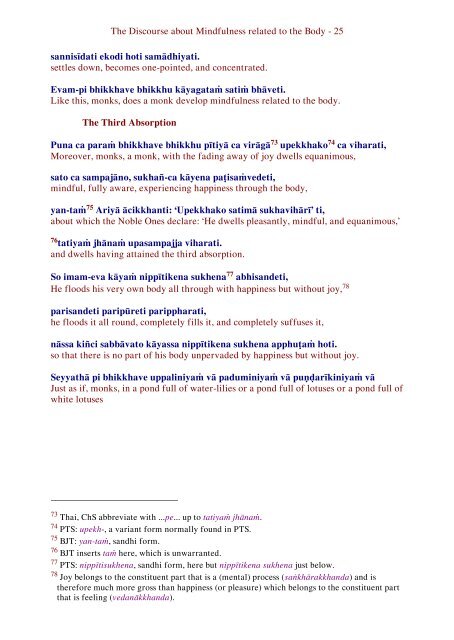Kayagatasatisuttam, the Discourse about Mindfulness related to the Body
A Pāli and English line by line (interlinear) version of this important discourse about the development of various meditations related to the body (together with extensive annotation).
A Pāli and English line by line (interlinear) version of this important discourse about the development of various meditations related to the body (together with extensive annotation).
You also want an ePaper? Increase the reach of your titles
YUMPU automatically turns print PDFs into web optimized ePapers that Google loves.
The <strong>Discourse</strong> <strong>about</strong> <strong>Mindfulness</strong> <strong>related</strong> <strong>to</strong> <strong>the</strong> <strong>Body</strong> - 25<br />
sannisīdati ekodi hoti samādhiyati.<br />
settles down, becomes one-pointed, and concentrated.<br />
Evam-pi bhikkhave bhikkhu kāyagataṁ satiṁ bhāveti.<br />
Like this, monks, does a monk develop mindfulness <strong>related</strong> <strong>to</strong> <strong>the</strong> body.<br />
The Third Absorption<br />
Puna ca paraṁ bhikkhave bhikkhu pītiyā ca virāgā 73 upekkhako 74 ca viharati,<br />
Moreover, monks, a monk, with <strong>the</strong> fading away of joy dwells equanimous,<br />
sa<strong>to</strong> ca sampajāno, sukhañ-ca kāyena paṭisaṁvedeti,<br />
mindful, fully aware, experiencing happiness through <strong>the</strong> body,<br />
yan-taṁ 75 Ariyā ācikkhanti: ‘Upekkhako satimā sukhavihārī’ ti,<br />
<strong>about</strong> which <strong>the</strong> Noble Ones declare: ‘He dwells pleasantly, mindful, and equanimous,’<br />
76 tatiyaṁ jhānaṁ upasampajja viharati.<br />
and dwells having attained <strong>the</strong> third absorption.<br />
So imam-eva kāyaṁ nippītikena sukhena 77 abhisandeti,<br />
He floods his very own body all through with happiness but without joy, 78<br />
parisandeti paripūreti parippharati,<br />
he floods it all round, completely fills it, and completely suffuses it,<br />
nāssa kiñci sabbāva<strong>to</strong> kāyassa nippītikena sukhena apphuṭaṁ hoti.<br />
so that <strong>the</strong>re is no part of his body unpervaded by happiness but without joy.<br />
Seyyathā pi bhikkhave uppaliniyaṁ vā paduminiyaṁ vā puṇḍarīkiniyaṁ vā<br />
Just as if, monks, in a pond full of water-lilies or a pond full of lotuses or a pond full of<br />
white lotuses<br />
73 Thai, ChS abbreviate with ...pe... up <strong>to</strong> tatiyaṁ jhānaṁ.<br />
74 PTS: upekh-, a variant form normally found in PTS.<br />
75 BJT: yan-taṁ, sandhi form.<br />
76 BJT inserts taṁ here, which is unwarranted.<br />
77 PTS: nippītisukhena, sandhi form, here but nippītikena sukhena just below.<br />
78 Joy belongs <strong>to</strong> <strong>the</strong> constituent part that is a (mental) process (saṅkhārakkhanda) and is<br />
<strong>the</strong>refore much more gross than happiness (or pleasure) which belongs <strong>to</strong> <strong>the</strong> constituent part<br />
that is feeling (vedanākkhanda).

















